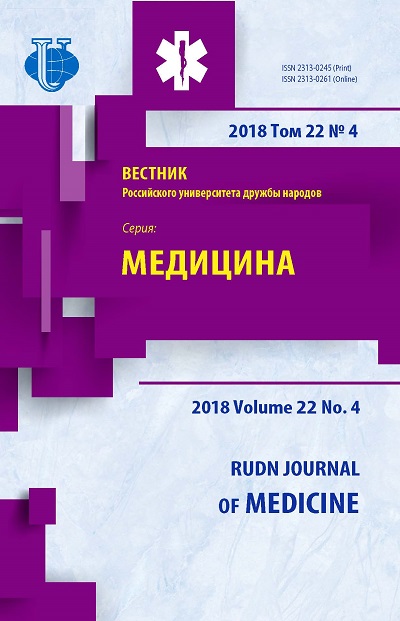NEW IN THE PATELLA FRACTURES TREATMENT
- Authors: Hijazin VH1, Solod EI1, Abdulkhabirov MA1, Karpovich NI1
-
Affiliations:
- RUDN University
- Issue: Vol 22, No 4 (2018)
- Pages: 456-463
- Section: TRAUMATOLOGY
- URL: https://journals.rudn.ru/medicine/article/view/20476
- DOI: https://doi.org/10.22363/2313-0245-2018-22-4-456-463
- ID: 20476
Cite item
Full Text
Abstract
In the literature there is a gap of publications about patella fractures management which is due to the absence of serious attention to the injuries of this largest sesamoid bone. In addition, in the world literature there is a lack of monographs and toolkits for the treatment of patients with these injuries, furthermore, in textbooks and traumatology manuals there are only a few template recommendations to the tactics of treating patients with this trauma. Meanwhile, patella fractures represent approximately 0.5-1.5% of all fractures, delayed union, formation of a false joint, and the emergence of patellofemoral arthrosis after these fractures is not uncommon. In the scientific literature on traumatology there is no unified, all-recognized classification of these fractures, which hinders the development of a single algorithm for the treatment of patients with patellar fractures. There are no contradictory views to the treatment of patella fractures without displacement; however, in relation to the treatment of patients with complex patella fractures, there are divergent views between the fracture fragments preservation to partial or even total patellectomy. In connection with the foregoing, We considered the issue of treating patients with patella fractures topical. Based on a thorough analysis of treatment results of 113 patients we provided a working classification based on the number of patellar fracture fragments (two-fragmentary, three-fragmentary, four-fragmentary, multi-fragmentary, upper and lower pole fractures). Based on this classification, traditional, modified and new methods of treating patients with patellar fractures were used. This is described in more detail in the forthcoming article.
Keywords
About the authors
V H Hijazin
RUDN University
Author for correspondence.
Email: hvalentino@mail.ru
SPIN-code: 7346-5972
PhD student, M.D., Medical Institute of the Peoples’ Friendship University of Russia
Miklukho-Maklaya Street 6, 117198, Moscow, RussiaE I Solod
RUDN University
Email: hvalentino@mail.ru
SPIN-code: 4964-3457
M A Abdulkhabirov
RUDN University
Email: hvalentino@mail.ru
SPIN-code: 1961-5326
N I Karpovich
RUDN University
Email: hvalentino@mail.ru
SPIN-code: 4516-5567
References
- Melvin S.J., Mehta S. (2011). Patellar fractures in adults. JAAOS — Journal of the American Academy of Orthopaedic Surgeons, 19(4), 198—207.
- Gwinner C. et al. Current concepts review: Fractures of the patella. GMS Interdisciplinary plastic and reconstructive surgery DGPW. 2016. Т. 5.
- Schuett D.J., Hake M.E., Mauffrey C., Hammerberg E.M., Stahel P.F., Hak D.J. (2015). Current treatment strategies for patella fractures. Orthopedics, 38(6), 377—384.
- Bergin P., Lawyer T.J. (2017). Patella Fractures. Orthopedic Surgery Clerkship (pp. 329—333). Springer, Cham.
- Neumann M.V., Niemeyer P., Südkamp N.P., Strohm P.C. (2014). Patellar fractures — a review of classification, genesis and evaluation of treatment. Acta chirurgiae orthopaedicae et traumatologiae Cechoslovaca, 81(5), 303—312.
- Bui C.N., Learned J.R., Scolaro J.A. (2018). Treatment of Patellar Fractures and Injuries to the Extensor Mechanism of the Knee: A Critical Analysis Review. JBJS reviews, 6(10), e1—e1.
- Kakazu R., Archdeacon M.T. Surgical Management of Patellar Fractures. Orthop Clin North Am. 2016 Jan; 47(1) pp:77—83.
- Litvina E.A. Resection and patellectomy in the manegment of closed patellar fractures: author's abstract of the dissertation.. Candidate of Medical Sciences: 14.00.22 State. honey. un-t. Moscow, 1995. 20 p.
- Ruedi T., Buckley R., Moran C. AO — Principles of fracture treatment, 2nd edition. 2013. p. 801—813.
- LeBrun C.T., Langford J.R., Sagi H.C. Functional outcomes after operatively treated patella fractures. J Orthop Trauma. 2012 Jul;26(7). pp. 422—6.
- Buezo O. et al. Patellar Fractures: An Innovative Surgical Technique With Transosseous Suture to Avoid Implant Removal Surgical Innovation 2015, Vol. 22(5), pp. 474—478.
- Sutton J.F.S. et al. The effect of patellectomy on knee function. The Journal of bone and joint surgery. American volume. 1976. Т. 58. № 4. С. 537—540.
- Müller E.J., Wick M., Muhr G. Patellektomie nach Traumabeeinflusst der Zeitpunkt das Ergebnis [Patellectomy after trauma: is there a correlation between the timing and the clinical outcome]. Unfallchirurg. 2003 Dec;106(12): 1016—9. doi: 10.1007/s00113-003-0690-x.
- Groves E.W.H. A note on the extension apparatus of the knee‐joint. British Journal of surgery. 1937. Т. 24. № 96. С. 747—748.
- Charles S Neer I.I. Displaced Proximal Humeral Fractures: Part I. Classification and evaluation. JBJS. 1970. Т. 52. № 6. P. 1077—1089.
- Neer Charles S. Four-segment classification of proximal humeral fractures: purpose and reliable use. Journal of shoulder and elbow surgery 11.4 (2002): 389—400.
- Hijazin V.H., Zagorodni N.V., Abdulkhabirov M.A. Osteosynthesis of multifragmentary patellar fractures. Patent of invention 2615665 from April 6, 2017.
- Prokopiev N.Ya., Malchevsky V.A., Kozel N.P. Gonoarthrosis: international systems for evaluating the results of rehabilitation measures (review of literature). Man. Sport. Medicine. 2007. No. 2 (74).
Supplementary files















